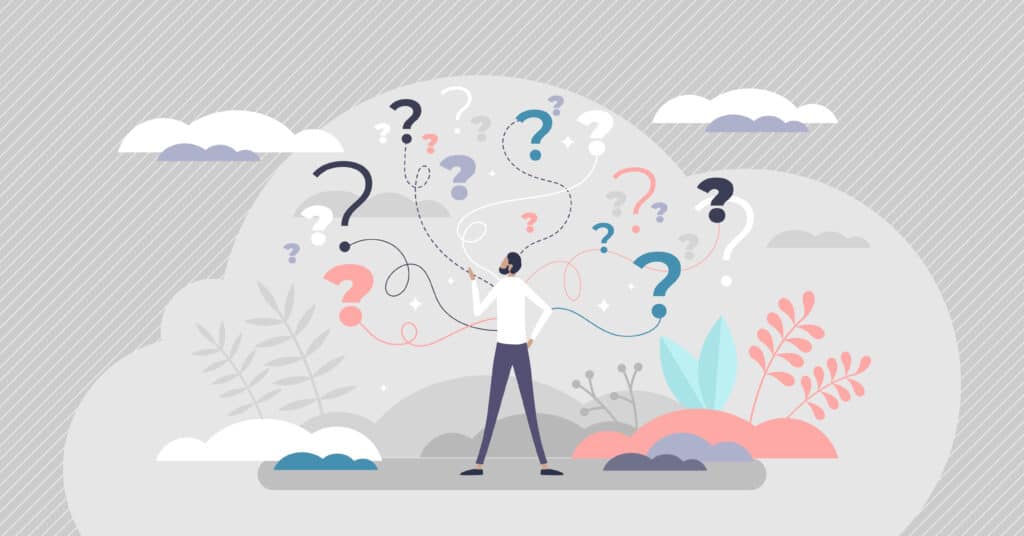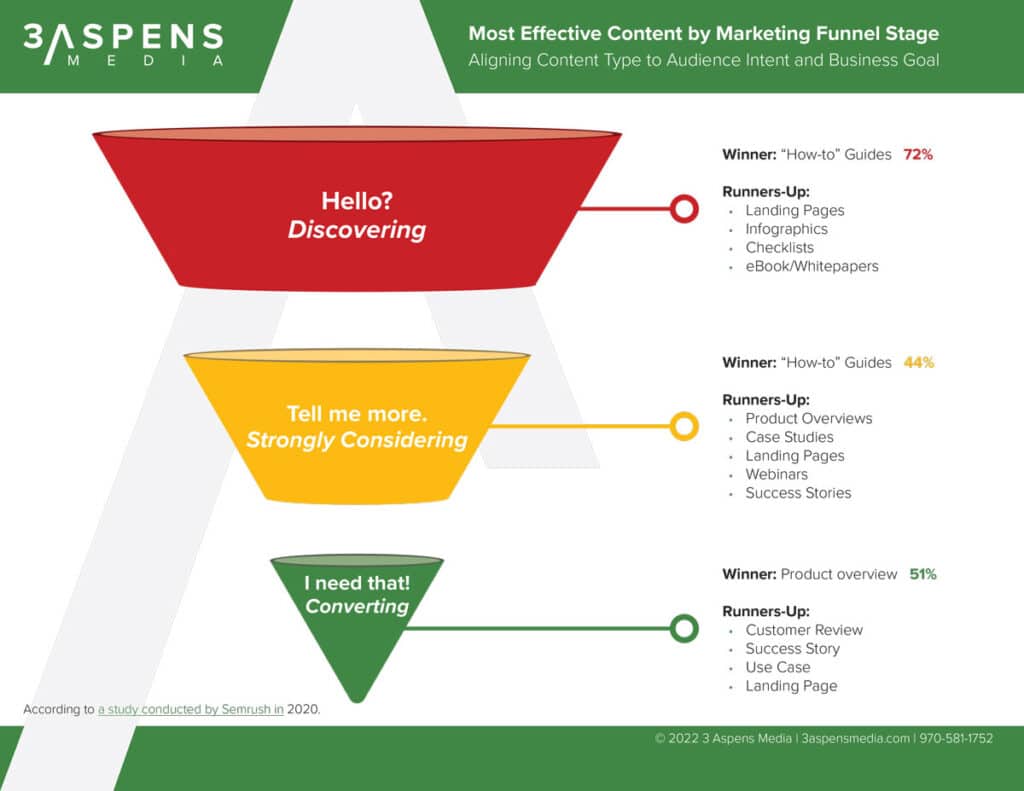Creating and publishing content without a content strategy isn’t ideal, but it isn’t all negative. It’s like a band showing up to a random place to play music. Brainstorming sessions, or random jams, can result in great ideas, or stellar performances that resonate with the audience. Getting them out in the world serves you better than holding onto them. And just going for it could result in memorable, impactful experiences.
But without a strategy, your content may not provide real value to your audience (i.e., prospects and buyers) and deliver results for your business. Just as a band that shows up to play AC/DC to a room full of seniors or teenagers might fall flat.
If you’re producing content without knowing your audience and business goals and how content can serve both, will it have an impact? And how will you be able to tell? Your efforts will go further and be more successful if you have a content strategy.
“When you don’t have a strategy, you can get stuck in a cycle of coming up with last-minute ideas hoping something will stick. It’s not strategic. It’s not focused. It’s a knee-jerk effort to create content for the sake of creating content. You won’t be effective if you don’t know your goals or what you’re measuring against.” – Teri Vannoy, Content Strategist at 3 Aspens Media
What is a Content Strategy?
A content strategy is your blueprint for mapping, managing and measuring the content you’ll produce in line with your overall marketing and business goals. Content strategies fuel content marketing plans, which are meant to engage potential buyers, answer their questions, solve their pain points and/or help them achieve a goal. At the same time, they should serve specific business goals and move prospects through the sales funnel.
“A content strategy is your plan to use content to attract, inform, educate and delight your target audience, move them through your sales funnel and achieve business goals. Like any plan or map, it keeps your content development efforts focused on an objective. Instead of producing content for the sake of production, you understand who, what, when, where and why you’re sending out messages.” – Teri Vannoy
Why is Content Strategy Important?
Having a content strategy is the best way to maximize your efforts. It ensures:
- Each piece of content has a clear roadmap to a defined purpose.
- Content is consistent, following a pre-defined structure that includes voice and tone.
- Content is produced consistently according to the strategy and schedule.
- Content produced will be quality due to thoughtful planning, coordination and execution.
- Content is more likely to direct the audience through the funnel or solve their problem – as intended.
- You’re less likely to produce ineffective content in a panic, publishing just to publish, without a plan.
- Anyone involved will be clear on objectives, tone, deliverables and expectations.
- You can measure content performance to quantify its value and find opportunities to improve.
- You can more readily demonstrate structure and purpose to stakeholders, improving buy-in.
- You’ll be better able to defend, protect and maintain your content strategy through company changes and transitions.
“Those that plan the battle don’t battle the plan. When you create a content strategy before producing content, stakeholders can participate and sign off on the plan. This gives them the opportunity to participate and illustrates to them that there’s structure. That saves a lot of time on the back end.” – Teri Vannoy
Learn and Adjust
Your roadmap may change as you reflect on content performance, so have a pencil ready to mark new roads and landmarks. Did you identify a shortcut? Did you uncover a new and valuable demographic? Map the “actual” to the “expected,” learn from it and continually adjust to optimize your content planning and production.
“Any company requires flexibility because we must be responsive to the current need and there’s no way for anybody to predict that. The plan is important. But having a plan doesn’t mean it’s rigid. If there’s an important reason to adjust the plan, do it.” – Teri Vannoy
What are the Components of a Content Strategy?
A content strategy details the individuals involved and their roles, the audiences you’re trying to reach, how you’ll reach them and on which platforms, which types of content you’ll produce and the goals for each type. You should document this plan and make it available to anyone involved in your content production efforts.
Business Goals
What do you hope to accomplish with the content you’re distributing? Goals of a content strategy that fuels marketing and business objectives may include:
- Driving revenue and purchases
- Generating leads for a service
- Increasing newsletter subscriptions
- Growing your audience (“following”)
- Developing brand awareness and trust
- Targeting new customers in new demographics
“Every company has their leadership put forth business goals they want to achieve, and then sales and marketing syncs up with that. Content should be no different. At 3 Aspens Media, we are an extension of our clients’ teams. The main things we need to understand are company business goals and sales and marketing objectives. If we’re not part of that communication chain, we’re not going to be in sync with the rest of the company.” – Teri Vannoy
Brand Identity
It’s important to include brand identity in your content strategy to determine how you’ll convey that identity in your content. For example, the tone, voice and style of your content should reflect your brand (serious, funny, academic, plain speak, etc.).
Competitive Research
Research what your competition does well and what they don’t do well – or at all. How do they perform in search? Which keywords do they rank for? Determine how you can differentiate yourself with your strategy. Also, research companies in other markets that produce similar content to yours. What can you learn from them?
Differentiators
Your industry differentiators should be central to your content strategy. Even the amount and type of content you produce can be characteristics that set you apart. If you’re offering frank answers to FAQs and developing useful technical guides where your competition is not, that is a differentiator.
Audiences
Most businesses and organizations have multiple audiences in their target markets. Do your research and define these audiences using “personas.” What are their needs, preferences and expectations? In your strategy, plan to speak directly to specific personas. Analytics can provide helpful insights around engagement and behavior, so you can better understand what customers care about. Analytics may also reveal:
- Your audience is different than you thought, with different needs than you expected.
- You’re reaching the wrong audience and need to adjust your strategy.
- There are opportunities with audiences you haven’t engaged.
“When working with clients, we must understand their target market. We need to be clear about the different personas, what the company knows about its target market and their perception of its target market. We also need to understand what their customers think about them. As part of our client onboarding process, interviewing customers is an important exercise. Sometimes, the perceptions don’t align. Having both is important.” – Teri Vannoy
Content Goals
Each content campaign or initiative, and each piece of content, should have a goal (ideally). It should deliver value to the customer and direct them toward an action. Understanding customers’ typical buying journey and how your content can help them navigate it is key to developing goal-oriented content.
For example, case studies are typically middle or bottom-of-the-funnel content pieces because buyers who read them seek social proof that you know what you’re doing. However, a blog post on how to select the right drill bit, would be top-of-funnel, where you’re introducing your brand and expertise, but a purchase is secondary.
Content Types and Topics
Identify which types of content you’ll create. This goes beyond deciding you’ll write blogs, whitepapers and case studies. What types of blogs will you write? What direction will your whitepapers take and what purpose will they serve? From there, you can determine the topics you’ll focus on.
Content Calendar
What will your content schedule look like? With an editorial calendar, you have a clear idea of content frequency and mapping. How often will you post blogs and social media? Will you alternate content types and topics? Or will you focus on a specific topic cluster or goal each month?
Platforms
Where will you distribute your content? This might include social channels or syndication, guest posting, etc. There are several channels for distributing content, which SemRush helpfully outlined in a comprehensive content distribution article.
Channels you own and control include your:
- Website and its associated landing pages, product pages and exclusive “gated” assets and resources that require login, registration, subscription or payment.
- Blog, which could include blogs, case studies and guides.
- Emails and newsletters, including announcements, invites, surveys and offers.
- Social media, YouTube and podcast platforms can promote content and events, engage the community and educate your audience.
On the other hand, there are earned distribution channels available to you if you build them out as part of your strategy. These include:
- Guest posts
- Forums and communities
- Review websites
- Brand mentions
Logistics
Who will be doing what as far as content? How will you manage and organize it? What content management system (CMS) will you use?
History
A content audit will be critical to your strategy if you have existing content. It will help you discover content to update, repurpose and toss, and how you might restructure existing content to fit your strategy. Believe it or not: Website content that hasn’t been visited in five years doesn’t need to stick around. In fact, Google will ding your site if you have a lot of obsolete content gathering dust in your archives.
Measurement
It may seem impossible to measure content performance, but there are clear metrics you can track and reference. You must determine how you’ll measure success so you can understand the effectiveness of your program and adjust for continual improvement. How you measure success will likely differ from how another company measures, as it depends on your specific goals.
According to Neil Patel, the seven most important metrics are:
- Traffic
- Search Engine Results Page (SERP) ranking
- Time spent on site
- Pages per visit
- Returning visitors
- Social sharing
- Clicks from social platforms
You might even create SMART goals for your content strategy, with each goal being specific, measurable, attainable, relevant and time-based.
B2B Content Strategy FAQs
With your strategy in place, it’s time to get granular about planning and executing effective content.
What role does SEO play in a content strategy?
SEO should be central to your strategy. SEO and related research can help you identify valuable topics based on current trends and your audiences’ interests. It also helps you measure your success and better understand what your audience does – and doesn’t – engage with.
SEO goes beyond structure and words on the page. It involves title tags and meta descriptions for SERPs, on-page media, alt tags for images and internal linking. Before you publish, be sure you’ve applied these seven ways to optimize blog posts for SEO. But remember that SEO shouldn’t dictate everything you write. If your customers have a frequent issue or concern, create content to address that and serve the needs of those customers.
How do you identify topics for a content strategy?
Coming up with topics may seem like a significant hurdle, but it doesn’t have to be.
- Use SEO research. Keyword, industry and behavioral research will help reveal your audiences’ interests. If some of those interests align with your goals, use those topics to inform your focus.
- Repurpose and reformat existing content. If you have content that’s outdated or needs tweaking for SEO purposes, include updates and repurposes as part of your strategy.
- Ask customers. Customer insight is the best source for content direction in any industry. Ask them about their concerns, needs and preferences and how you might serve them better with content.
- Ask front-line employees. Ask them what they’re asked most often, and plan to answer those questions as part of your content strategy.
- Spy on your competition. Use competitive research to discover important topics in your industry. Be sure to highlight your differentiators in your own content on these topics.
- Follow social media. What are your peers talking about on LinkedIn, Twitter and other social media platforms?
Quick topic ideas to get your wheels turning:
Customer stories. If you have a great example of how you’ve helped a client, interview them for a case study that you can feature as part of your strategy.
Employee stories. If your selling point is your team and service, plan to put your team members front and center with Q&As.
Insights from internal experts (also known as Subject Matter Experts). Invite experts at your company to contribute on topics they know well or interview them and write content for them.
Current issues. Address new developments that affect your customers.
How do you align content to purpose?
Each piece of content should have a goal and position in the funnel. For instance, if the goal is to build awareness about your product or service, it’s too soon to talk about specific functions and details.
Prospective customers at the top of the funnel are floating by and taking a look as they go. They’re in your store, but they don’t want help.
Customers at the bottom of the funnel need assistance and specific answers. You shouldn’t leave them waiting. If you do, they’ll probably head to your competitor’s site.
Here are a few examples of aligning your goals to the customer journey – or assigning purpose.
- Top of Funnel: According to Contently, this is “the land of brand awareness and affinity.” This is your goal. Let’s say you run a koala bear rescue. For awareness, create an article with pictures of cute koalas and facts that explain how cool they are and why they need rescuing in the first place. Share cute koalas and associated facts on social media. Here, the audience is intrigued enough to click – and enter the funnel. You’ve made them care, and they now identify you as an expert in koalas.
- Middle of Funnel: This is where prospective customers see your logo on the page and wonder, how exactly does this organization help koalas? And do I want to be part of it? Here, direct them to information about your organization, its impact (stats and stories) and the issues it addresses. You might highlight Kayla the koala and her health journey and encourage readers to sign up for your newsletter to follow her progress. In this example, newsletter subscriptions are your goal.
- Bottom of Funnel: Here, people want to take action. Your content should give them the tools and information they need to do so. What does a $20 donation do for your rescue? What will the donor receive for their contribution? Where should they send it and how can they write it off on their taxes? Your goal here is to get donations – or capture the lead.
Want to know which content types work best – statistically – for each stage of the funnel?
How do you present a content strategy
Without buy-in from stakeholders at your company, your content strategy will go nowhere. How you present it can make or break that buy-in. Three common scenarios for presenting a content strategy are:
- Making a business case for having a strategy in the first place
- Presenting a requested strategy to executives or clients
- Presenting to relevant individuals like writers and marketers on your team
One of the most effective ways to deliver your strategy is in an actual presentation. In most cases, you can simply transfer your documented strategy into a presentation with dynamic visuals and shorter descriptors. Make the presentation downloadable and referenceable for relevant parties and stakeholders.
Customize the information you include to fit the audience. For instance, if you’re making a business case, include statistics that support your goals and define metrics you’ll use to measure success. If you’re presenting to writers, emphasize the most relevant details to them, such as voice and style.
What challenges come with developing a content strategy?
Finding the time. It’s difficult to find the time and resources to develop and execute a content strategy, particularly given the ramp-up time and difficult-to-quantify returns. It may seem simpler to jump to content production, but your content will be much more effective if you take the time to strategize.
Analysis paralysis. As with many decisions in business, it’s often difficult to decide on the details of a strategy once you’ve done the information gathering and everything is laid out in front of you. It can be overwhelming. Sometimes, it’s best to start small.
Buy-in issues. Other stakeholders in the business may not buy into or understand your strategy. As a result, it may not get off the ground, or they may try to change the direction to better fit their own agendas.
The silo problem. In B2B, most of us are familiar with the issue of silos. When it comes to following through on a content strategy, it’s important those who are involved with and directly affected by the content connected to one another. For instance, your marketing team should communicate with your content producers, especially if they’re outsourced. And if you’re creating sales materials, your content producers should have access to your sales team for input and feedback.
Should you have different strategies for web vs. print?
Content strategy for the web involves components of your plan that relate to publishing on the internet, whether your website, social media, guest blogs for trade magazines or any other online platform. Content strategy for print involves channels like print newsletters, magazines, brochures, pamphlets and advertisements.
We recommend taking a holistic approach rather than looking at them as separate strategies. Print and web are just two channels for your content. Where that content is published depends on your audience and the best place to reach them. Apply the insights you’ve gained from research in both areas across the formats. SEO research, for instance, can help you determine what audiences are interested in and how they prefer their content structured. And analyzing how different regions and demographics respond to your print content can help you determine where to target your web content.
What to Expect When You Outsource Content Strategy
At 3 Aspens Media, when we work with clients on content strategy, we ask for:
- A thorough “download” conversation regarding the company and its goals to gain a solid foundation of insight and knowledge.
- All written materials already produced, including emails, sales sheets and leave-behinds.
- A conversation about what’s worked and what hasn’t in the past as far as these written materials. This goes beyond a simple content audit so we can understand their history – mistakes and all – to better approach future content.
- Examples of other content in the world that reflects their own hopes and expectations, as well as explanations as to why they prefer that content and what specifically they like about it.
Curious about the nitty-gritty? Here’s an insider’s look at our typical content strategy questionnaire.
Just Do It
Developing a content strategy can get weedy and complicated, and the process can be a year-long nightmare if you approach it aiming for perfection.
Truly, it’s okay to start small. Put your core values and objectives in place, do some cursory SEO research, know who you are and how you want to present yourself, and answer your customers’ questions. Starting is as simple as that.
Along the way, you’ll grow your strategy and fine-tune your processes. If you wait until your strategy is fully fleshed out, you’ll miss valuable opportunities to help your business grow. As our founder once wrote, slow and steady wins the content marketing race.
What does this process look like when you work with a content firm like ours? Learn more about how we write blogs for our clients (so they don’t have to) and reach out to us today at info@3aspensmedia.com.






